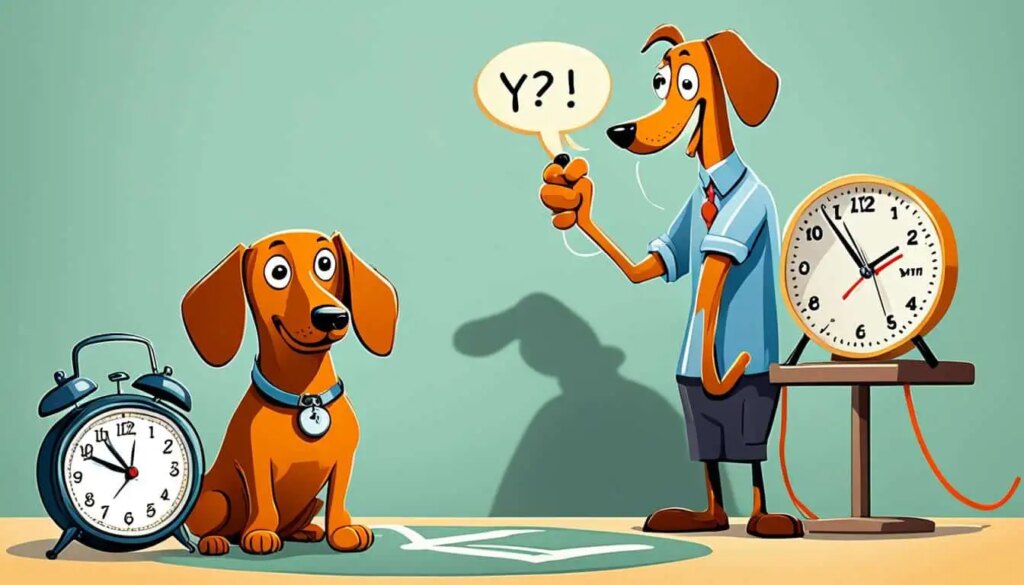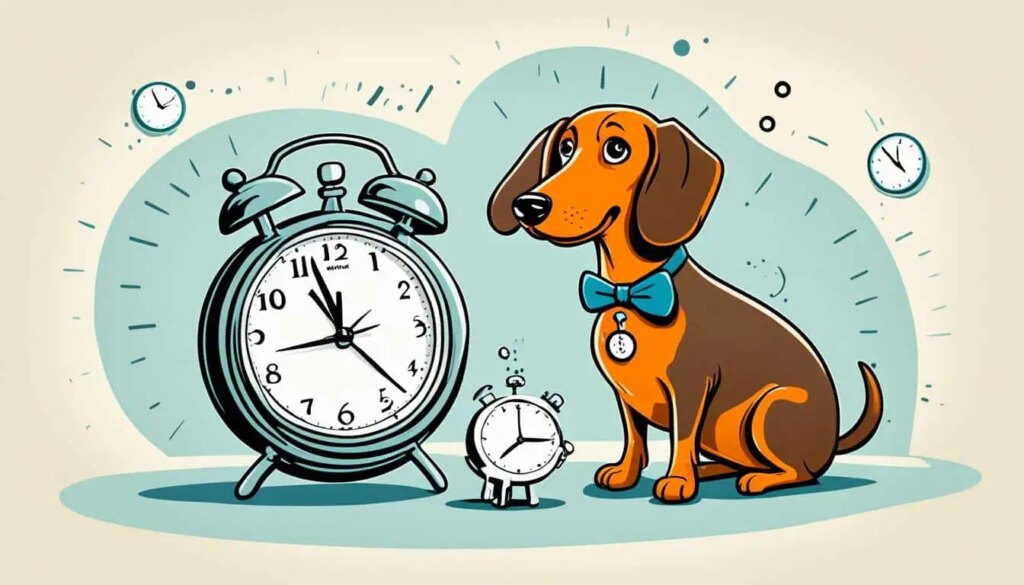Did you know that Dachshunds have one of the smallest bladder capacities among dog breeds? Despite their lovable and resilient nature, these adorable wiener dogs have a limited bladder control capability. Understanding the duration they can hold their bladder is essential for Dachshund owners, especially during the potty training phase.
Key Takeaways:
- Dachshunds have a smaller bladder capacity compared to other dog breeds.
- The duration a Dachshund can hold its bladder depends on various factors such as age, health, and size.
- Consistent potty training and a regular bathroom schedule are crucial for improving Dachshund bladder control.
- It’s important to recognize the limits of Dachshund bladder control and seek veterinary advice if bladder issues arise.
- Supporting your Dachshund’s bladder health includes providing ample opportunities for them to relieve themselves and ensuring adequate hydration.
Understanding Dachshund Bladder Capacity
In order to properly care for your Dachshund’s bladder health, it’s important to understand their bladder capacity and the factors that influence it. Dachshund bladder capacity can vary based on age, size, health, and activity levels. By familiarizing yourself with these factors, you can better support your Dachshund’s bladder function and overall well-being.
Factors Influencing Bladder Size and Control
Several key factors can impact the size and control of a Dachshund’s bladder. These include:
- Age: Younger Dachshunds may have smaller bladders and less control, while older dogs typically have larger bladders and improved control.
- Size: The size of your Dachshund can play a role in bladder capacity, with larger dogs generally having larger bladders.
- Health: Certain health conditions, such as urinary tract infections or bladder stones, can affect bladder size and control.
- Activity Levels: Regular exercise and physical activity can help strengthen the muscles surrounding the bladder and improve control.
Average Bladder Capacity in Dachshunds
The average bladder capacity in Dachshunds can vary, but it is typically around 10-15 milliliters per pound of body weight. For example, a 10-pound Dachshund may have a bladder capacity of approximately 100-150 milliliters. However, it’s important to note that individual dogs may have slightly different bladder capacities based on the factors mentioned earlier.
Signs of Healthy Bladder Function
Recognizing the signs of healthy bladder function in your Dachshund can help you monitor their overall bladder health. Some indicators of a healthy bladder include:
- Regular and consistent urination: Your Dachshund should have a regular bathroom schedule and be able to empty their bladder completely.
- No signs of discomfort or straining: Healthy bladder function should not be associated with any signs of pain, discomfort, or difficulty while urinating.
- Absence of accidents or frequent urination: A healthy Dachshund should be able to hold their urine for an appropriate amount of time without having accidents or needing to urinate excessively.
Understanding these factors and signs of healthy bladder function will allow you to better monitor your Dachshund’s bladder health and take appropriate steps to ensure their well-being.

How long can a Dachshund hold its bladder?
As a Dachshund owner, it’s essential to understand how long your furry friend can hold their bladder to ensure their comfort and well-being. While the exact duration can vary depending on several factors, including age, health, and individual differences, there are general guidelines you can follow.
Dachshunds, like other small breeds, have relatively small bladders and may need to relieve themselves more frequently compared to larger dogs. Puppies have even smaller bladders and will need bathroom breaks more frequently than adult Dachshunds. Generally, puppies and young Dachshunds can hold their bladder for about one hour for every month of age, up to a maximum of eight hours.
Adult Dachshunds, on the other hand, can typically hold their bladder for six to eight hours during the day, assuming they have regular access to bathroom breaks. However, it’s important to note that this duration can vary depending on individual differences, health conditions, and the availability of water and times for bathroom breaks.
To ensure your Dachshund’s bladder control, it’s crucial to establish a regular bathroom schedule. Take your Dachshund outside to relieve themselves first thing in the morning, and then every two to four hours throughout the day. Additionally, provide opportunities for bathroom breaks 30 minutes after meals and before bedtime.
Monitoring your Dachshund’s water intake can also help in managing their bladder control. Limiting water access two to three hours before bedtime can reduce the likelihood of nighttime accidents.
However, it’s important to balance bathroom breaks with the understanding that Dachshunds require regular exercise and mental stimulation. Ensuring regular playtime and walks throughout the day will contribute to their overall well-being, but it may also result in the need for more frequent bathroom breaks.
By understanding how long your Dachshund can hold their bladder and implementing a consistent bathroom schedule, you can help them maintain proper bladder control and avoid accidents in the house.
Training Your Dachshund for Improved Bladder Control
Properly training your Dachshund is essential for improving their bladder control. By implementing effective potty training strategies, creating a regular bathroom schedule, and teaching your Dachshund to hold their pee, you can help them develop good bathroom habits and strengthen their bladder control.
Essential Potty Training Strategies
When it comes to potty training your Dachshund, consistency, patience, and positive reinforcement are key. Here are some essential strategies to consider:
- Use crate training: Crates provide a safe and comfortable space for your Dachshund and can be used as a tool for potty training. By using the crate effectively, you can establish a routine and teach your Dachshund to associate the crate with going potty outside.
- Establish a designated potty area: Choose a specific spot in your yard where you want your Dachshund to go potty. Take them to this area consistently and reward them with praise or treats when they go potty in the correct spot.
- Monitor your Dachshund: Keep a close eye on your Dachshund to prevent accidents indoors. Look for signs such as sniffing or circling, which indicate they need to go potty, and quickly redirect them to the designated area.
- Use positive reinforcement: Reward your Dachshund with praise, treats, or a favorite toy when they successfully go potty outside. This positive reinforcement helps reinforce the desired behavior and encourages them to continue practicing good bathroom habits.
Creating a Regular Bathroom Schedule for Your Dachshund
Establishing a regular bathroom schedule is crucial for improving bladder control in Dachshunds. By following a consistent routine, you can prevent accidents and help your Dachshund understand when it’s time to go potty. Consider the following tips:
- Take your Dachshund outside first thing in the morning, after meals, and before bedtime.
- Set specific times throughout the day for bathroom breaks, such as every 2-4 hours, depending on your Dachshund’s age and bladder capacity.
- Keep track of your Dachshund’s potty habits to identify any patterns or signs that they need to go.
- Stick to the established schedule consistently to reinforce the routine and help your Dachshund anticipate bathroom breaks.

Tips for Training a Dachshund to Hold Pee
Training your Dachshund to hold their pee can be beneficial for situations where access to a bathroom may be limited. Here are a few tips to help you with this training process:
Tip 1: Gradually increase the duration between bathroom breaks. Start by adding a few minutes to the time between breaks and gradually extend the intervals as your Dachshund becomes more comfortable holding their pee.
Tip 2: Provide physical and mental stimulation to distract your Dachshund from the urge to pee. Engage them in activities such as playtime, training sessions, or puzzle toys to keep their mind occupied.
Tip 3: Be patient and understanding during the training process. It takes time for Dachshunds to learn to hold their pee, so avoid punishing accidents and instead focus on reinforcing positive behaviors.
By implementing these training techniques, you can support your Dachshund in developing better bladder control and maintaining good bathroom habits.
Conclusion
In conclusion, understanding the limits of Dachshund bladder control is essential for their overall well-being. While Dachshunds have varying bladder capacities, it is important to recognize that they have smaller bladders compared to larger breeds. This means they may need more frequent bathroom breaks and may not be able to hold their pee for extended periods of time.
To support your Dachshund’s bladder health, there are several measures you can take. First, ensure they have access to fresh water throughout the day to prevent dehydration, as this can lead to bladder issues. Additionally, consider feeding them a high-quality, balanced diet that supports urinary tract health. Finally, incorporating regular exercise into their routine can help promote bladder control and a healthy urinary system.
If you notice any signs of bladder problems in your Dachshund, such as frequent accidents, difficulty urinating, or blood in their urine, it is crucial to consult a veterinarian. They will be able to provide a proper diagnosis and recommend appropriate treatment options. Remember, early detection and intervention can help prevent more serious bladder issues down the line.
In summary, by recognizing the limits of Dachshund bladder control and implementing strategies to support bladder health, you can ensure that your furry friend maintains optimal urinary function. Remember to be attentive to their needs, provide them with proper care, and seek veterinary attention when necessary. With these measures in place, you can help your Dachshund lead a happy and healthy life.
